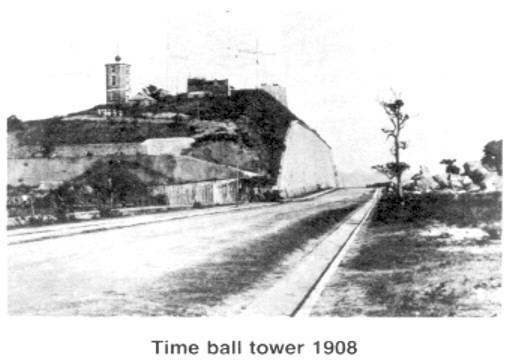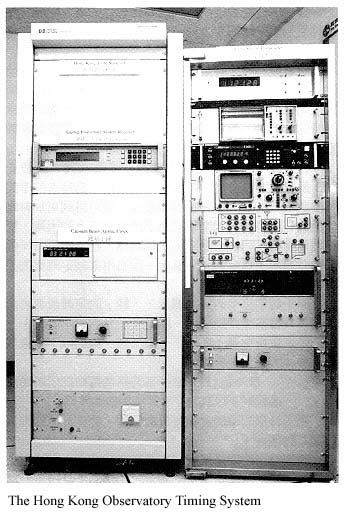The Hong Kong Time Service
The Time Scales
: The first timing system in the world was based on the sundial, and the time measured was apparent solar time.However, apparent solar time is not uniform because the earth's orbit is not circular and its speed changes with its distance from the sun. There is also an effect due to the inclination of the earth's equatorial plane to the plane of its orbit. A more uniform time called mean solar time was therefore introduced. Universal Time (UT0) is mean solar time at the Greenwich Meridian and is called Greenwich Mean Time (GMT).
As better clocks were developed, astronomers began to notice a discrepancy in UT0 measured at different locations. This was later found to be caused by a wobble in the axis of the earth. After careful measurements at various observatories throughout the world, the effect of the wobble was eliminated by the introduction of a new time designation called UT1.
With further improvements in the precision of pendulum and quartz clocks, it was discovered that UT1 had periodic variations caused by the seasonal fluctuations in the rate of rotation of the earth. Corrections were made to remove their effect and an even more uniform time UT2 was obtained. Astronomers avoided the difficulty by establishing a time scale based on the earth's movement around the sun, the Ephemeris Time. But this time scale is unsuitable for general use because of the delay in the astronomical observations used to define it.
Research on atomic frequency standards indicated that an alternative basis for a definition of the 'second' might be possible and in 1967 the Thirteenth General Conference of Weights and Measures adopted a resolution to replace the astronomical definition of the second by : -
"The second is the duration of 9 192 631 770 periods of the radiation corresponding to the transition between the two hyperfine levels of the ground state of the caesium-133 atom."
The atomic time scale is accurate to a few billionths of a second as compared with a few thousandths of a second in one day in the case of Universal Time.
The International Atomic Time Scale (TAI) is the international reference scale of atomic time based on the seconds as defined above in the International System of Units (SI). It is in the form of a continuous scale, i.e. in days, hours, minutes and seconds from the origin 1958 January 1 d 0 h 0 min 0 s.
At the beginning of 1972 a compromised time scale known as Co-ordinated Universal Time (UTC) was changed to a new standard so that 1972 January 1 d 0 h 0 min 0 s UTC coincided precisely with 1972 January 1 d 0 h 0 min 10 s TAI. This was accomplished by a step of 0.107 757 7 second being taken out of UTC. Also on 1 January 1972, the duration of 1 second UTC was shortened by about 30 nanoseconds so as to equal the second on the TAI scale. To ensure that UTC and UT1 would never differ by more that 0.9 second, provision was made for the introduction from time to time of "leap seconds" in the UTC scale. As TAI is currently gaining on UTC positive leap-seconds as required. Although UTC will differ from TAI by an integral number of second, its seconds "markers" will always coincide with those of TAI.
The International Bureau of Weights and Measures (BIPM) and the Central Bureau of International Earth Rotation Services (IERS/CB) are the agencies responsible for international co-ordination of time and frequency standards. By international agreement, all UTC time scales must agree with the UTC time scale operated by BIPM and IERS/CB to within 1 millisecond. The result is a uniform world time system that differs from country to country by only a few millionths of a second. Under the co-ordination of BIPM and IERS/CB, several national laboratories, such as the Communications Research Laboratory, Japan, operate primary time standards and provide time services on an international basis.
The Hong Kong Timing System
: The Hong Kong Observatory was established in 1883 to provide amongst other things a time service based on astronomical observations. The local time was determined by astronomical observations at the Observatory using a 6-inch Lee Equatorial and a 3-inch Transit Circle. The time signals were indicated by dropping a time ball from a mast in front of the Police Station at Tsim Sha Tsui. The time ball was dropped for the first time on 1 January 1885 at 1300 hours local time. The time ball tower was later moved to Blackhead Point in January 1908.In 1904 Universal Time (i.e. Greenwich Mean Time) was adopted as the basis for Hong Kong time (8 hours in advance of Greenwich Mean Time). With the introduction and wider use of time signals on radio broadcast, the time ball was dismantled on 30 June 1933.
The Observatory's instruments were lost during the Second World War and after the war pendulum clocks were installed and regulated by radio time signals from other centres. Timing accuracies gradually improved from seconds to within one-fifth of a second.
In 1966, a crystal-controlled timing system was installed to replace the pendulum clocks. Daily comparison with time signals received from other stations kept the accuracy to 80 milliseconds. Direct broadcasting of the 6-pip time signal from the Observatory on 95 MHz also commenced in the same year.
On 1 January 1972, Hong Kong adopted UTC as the official time standard. A timing system based on a Caesium Beam Atomic Clock was first acquired in 1980 and a replacement clock was installed in 1994. The frequency standard controlling the clock is a primary standard with accuracies of fractions of a microsecond a day and it is traceable to the primary standard of the Communications Research Laboratory in Japan.
The Hong Kong Time Service
: The Hong Kong Observatory's time service is based on the Caesium beam atomic clock with an accuracy of fractions of a microsecond a day. Such a level of accuracy is important to scientists, industrialists and other professionals whose work requires it. A Global Positioning System is also installed as a backup to the atomic clock for providing the time service. The public can easily carry out time checks from the Observatory's time-server through Internet (address: https://www.weather.gov.hk/en/nts/ntime.htm), the Observatory's "Dial-a-weather" System (telephone number: (852) 1878 200) and the 6-pip time signals broadcast by Radio Television Hong Kong (RTHK).Details of the time signals broadcast from different stations are listed as follows :
| Station | Frequency | Time of Broadcast |
|---|---|---|
| Radio Television Hong Kong |
||
| Radio 1 (Chinese Programme) |
92.6-94.4 MHz* | 0600-2230 HKT : Hourly on the hour and half hourly 2300-0600 HKT: Hourly on the hour |
| Radio 2 (Chinese Programme) |
94.8-96.9 MHz* | 0600-2230 HKT : Hourly on the hour and half hourly 2300-0600 HKT: Hourly on the hour |
| Radio 3 (English Programme) |
567 kHz and 1584 kHz(AM)
|
Hourly on the hour |
| Radio 4 (English & Chinese Programme) |
97.6-98.9 MHz* | Hourly on the hour except Monday 1400, 1500 HKT, Wednesday 2100 HKT, Thursday, Friday 1400, 1500, 2100 HKT and Saturday 2100 HKT |
| Radio 5 (Chinese Programme) |
783 kHz |
0600-0930 HKT : Hourly on the hour and half hourly 1000-1900 HKT: Hourly on the hour 2000-2230 HKT : Hourly on the hour and half hourly 2300-0500 HKT: Hourly on the hour |
| Radio 7 (Chinese Programme) |
621 kHz
|
0600-0200 HKT : Hourly on the hour and half hourly |
| * Frequency Modulated Transmission |

